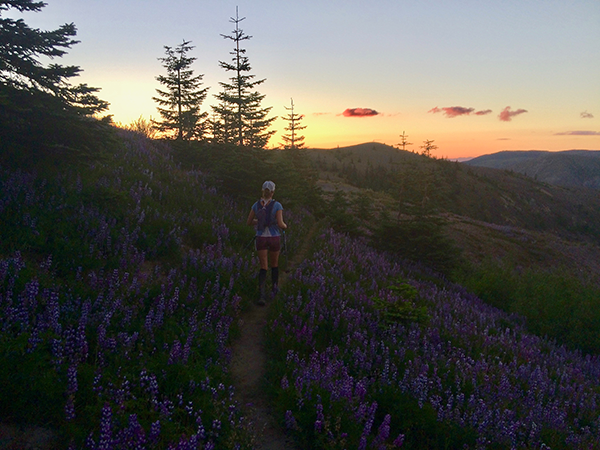I glanced around at the runners attending the pre-race meeting for the 2017 Bigfoot 100 k ultramarathon and realized, grimly, that I was way out of my league. These were veterans: rugged, experienced, and stoic as race director Candice Burt described the various hazards that we would encounter the next day. I, however, was trying to dislodge my heart from the back of my throat.
Snowfields lingered in the high country, Bigfoot was on the lam, and now—did I hear that correctly over the sound of my own hyperventilation—there would be a middle-of-the-night river crossing with embankments so steep and loose we would need to use fixed ropes? That tidbit was NOT in the runner’s manual! And this news coming after only two weeks prior learning that the course had been altered due to snow-blocked roads, which would add six additional miles and an extra 1,000 feet of vertical ascent. And now, apparently, I would need to channel my inner Tarzan.
In all fairness, the Destination Trail crew faced a difficult decision in altering the course last-minute, and they did an unbelievable job making the changes seamless. The course was well-marked, the five aid stations were supremely stocked (I’m talking quesadillas and hot bacon here, people), and time was added to the overall cutoff to compensate for the extra mileage.
While the safety meeting had left me a bit rattled, the next morning I felt determined to go out and kick some butt. My pre-race nerves morphed into jolts of excitement. I couldn’t wait to experience the wild, unpredictable adventure that ultrarunning embodies, and to challenge my mental and physical limits. I had trained hard and smart, and I had a strategy for anything that might come my way.

The gun went off and I began my exploration of the rugged course, which circumnavigated Mt. St. Helens and looped through the desolation zone of the 1980 eruption. I imagined myself on the moon’s surface as I traversed vast stretches of treeless pumice fields and gazed into the volcano’s crater. Rambling through the Mount Margaret Backcountry, I was rewarded with incredible vistas of hanging lakes, with Hood, Adams, and Rainier gracing the background. The terrain was tough and technical, with lava boulder fields, deep desert-like ash and sand, and 28,606 feet of elevation change over 68 miles. It all made for a monumental challenge.
Ultimately, I handled every blow that the Bigfoot dealt me: unrelenting July heat, lack of shade, shoes full of ash, blisters, GI issues, and heat rash. I pulled out of every negative spiral I fell into. In fact, if there’s one takeaway that I would pass along to first-timers, it would be to prepare for the worst. It may sound cynical, but due to the sheer distance and time involved in completing an ultra, anything can happen on race day. Create contingency goals, plan for things to go awry, and carry essential supplies and first aid in your pack.
Shortly after sunrise, lured by the enticing aroma of breakfast burritos wafting from the finish line, I shuffled through my final paces and nabbed my handcrafted finisher medal. With the support of my amazing husband and friend who paced me through the night miles, I ran for 22 hours and 44 minutes and had the absolute time of my life. Oh, and my favorite part? Fording the Toutle River using those dreaded fixed ropes.
If this sounds like the perfect challenge for you, the 2018 race will take place on August 10. There’s also 20, 40, and for you crazies, 200-mile options. Details can be found at Bigfoot200.com. // (Sarah Oscarson)
Ultrarunning Training & Racing Tips
Train the course. Study the race course in advance and incorporate challenging elements, such as river crossings, long grueling ascents/descents, high altitude, and snow into your training.
Nutrition, nutrition, nutrition. You’ve heard it a million times but it’s oh-so-critical. Experiment during training and find foods and drinks that you can consume while running, especially on an upset stomach.
Break it down. Visualizing the total mileage of an ultra can feel overwhelming. Break it down into smaller distances by using aid stations as landmarks, and only focus on one segment at a time.
Just keep moving. Run, walk, crawl, limp…do whatever it takes. Prolonged stops, while sometimes necessary, will cause muscles to stiffen and motivation to wan. Plus, the clock’s a-tickin!
Climb aboard the ultra-coaster. In training and on race day there will be exquisite highs and devastating lows. Learning to coast on through is the key to ultrarunning enlightenment. When things get tough, remember why you’re doing this, and try to enjoy the crazy ride. //
Sarah will try to heed her own advice this August as she attempts the Cascade Crest 100-mile ultramarathon. She last wrote about solo bike touring in June of 2017.
Feature photo: Crossing through the stark blast zone. // Joel Oscarson
Originally published in the April 2018 print edition of Out There Outdoors under the title “Run Like Bigfoot is Chasing You.”













